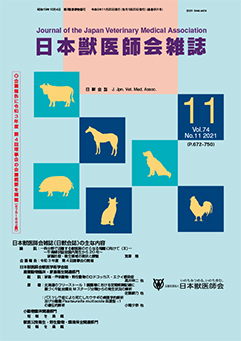
- |<
- <
- 1
- >
- >|
-
Shinji TAKAI, Hiroo MADARAME, Yukako SASAKI, Yasunori SUZUKI, Tsutomu ...Article type: Review
2021Volume 74Issue 11 Pages 695-706
Published: November 20, 2021
Released on J-STAGE: December 20, 2021
JOURNAL FREE ACCESSDownload PDF (633K) -
Ayano SATO, Issei WATANABE, Yoshitada SHINOHARA, Masahito TAKATORI, Ry ...Article type: Original Article
2021Volume 74Issue 11 Pages 707-713
Published: November 20, 2021
Released on J-STAGE: December 20, 2021
JOURNAL FREE ACCESSBovine digital dermatitis (DD) is classified into M stages, ranging from M0 (Healthy), M1, M2, M3, M4 and M4.1 and is prone to recurrence. In this study, we recorded the M-stage classification of DD at 504 limbs in 126 Holstein-Friesian dairy cattle in April 2020 at a freestall dairy farm in Hokkaido, during regular foot trimming. We analyzed the data to reveal the occurrence of DD and to take preventive measures. As the method, we determined the prevalence of active DD (aDD). Then, the objective variable was set at each M-stage classification of DD by binomial logistic regression analysis, while the explanatory variables were the observation places, the number of calving, and the last three observations during hoof trimming up to February 2019. The results showed that prevalence of aDD cattle was 24.6%, and a high ratio of aDD was observed in a herd consisting mainly of first lactation cattle. Further, aDD was more common where it had been recorded in the past. Our study, in which hoof trimming information was recorded and analyzed according to M-stage classification, provided useful information for herd management and was believed to be the first report of its kind in Japan.
View full abstractDownload PDF (466K) -
Yuna KOGIKU, Akiho KATAYAMA, Naohito OKAZAKI, Kaori HOSHINOO, Yuichi U ...Article type: Original Article
2021Volume 74Issue 11 Pages 714-720
Published: November 20, 2021
Released on J-STAGE: December 20, 2021
JOURNAL FREE ACCESSIn a rabbit breeding facility, 10 rabbits died successively within a week. Upon the pathological examination of a rabbit, necrotizing hemorrhagic bronchopneumonia was found. Pasteurella multocida was isolated from the lung lesion. A capsular typing polymerase chain reaction of the isolate yielded both types A- and F-specific amplification products. DNA sequencing of its capsule biosynthetic loci revealed that the isolate preserved all sequences of types A and F primer design sites. However, the capsular serotype of the isolate could not be determined by an indirect hemagglutination reaction. The isolate was classified into sequence type (ST) 4 using multilocus sequence typing following the Rural Industries Research and Development Corporation (RIRDC) scheme. This is the first report on the isolation from a rabbit of a P. multocida grouped into clonal complex 171 consisting of ST4, ST36, ST39, ST56, ST66, ST117, ST171, ST263, ST270 and ST275.
View full abstractDownload PDF (1130K) -
Manabu YAMADA, [in Japanese], [in Japanese], [in Japanese], [in Japane ...Article type: Data and Information
2021Volume 74Issue 11 Pages 721-731
Published: November 20, 2021
Released on J-STAGE: December 20, 2021
JOURNAL FREE ACCESSDownload PDF (23744K)
-
Daisuke KOJIMA, Kyoko KOJIMA, Kazumi OTA, Yoshihiko KOJIMAArticle type: Short Communication
2021Volume 74Issue 11 Pages 733-737
Published: November 20, 2021
Released on J-STAGE: December 20, 2021
JOURNAL FREE ACCESSA 14-year-old, spayed female cat with a 4-year history of diabetes mellitus and skin fragility was presented with anorexia and lethargy. Despite symptomatic treatment for approximately one month, the cat died. At necropsy, skin atrophy and numerous yellowish white nodules were observed in the subcutaneous fatty tissue of the trunk. In addition, mass lesions were also observed at the pancreas and right adrenal gland. Histopathological examinations revealed pyogranulomatous panniculitis, atrophic dermatosis characterized by a thin epidermis, sparse collagen fibers and atrophic follicles and sebaceous glands, pancreatic adenocarcinoma and adrenal cortical adenoma. In this case, pyogranulomatous panniculitis and atrophic dermatosis were suspected to be associated with adrenal cortical adenoma and pancreatic adenocarcinoma, respectively.
View full abstractDownload PDF (3870K) -
Yuka ODAHARA, Ikki MITSUI, Masaki MICHISHITA, Toshikazu TAKAHASHIArticle type: Short Communication
2021Volume 74Issue 11 Pages 738-742
Published: November 20, 2021
Released on J-STAGE: December 20, 2021
JOURNAL FREE ACCESSMuscle tremors were presenting in a 10-year-old spayed-female cat. The cat was hypoglycemic, and an abdominal ultrasound revealed a hypoechoic nodule in the pancreatic body. Insulinoma was clinically suspected, and the oral administration of prednisolone was initiated. The cat's clinical symptoms improved and blood glucose was successfully controlled by oral prednisolone administration alone. The cat's general condition gradually deteriorated, and she died 32 months after initiating treatment. A complete necropsy with histopathological and immunohistochemical examinations revealed islet cell carcinoma (malignant insulinoma) in the pancreatic body with metastasis to the liver. The low growth rate of the tumor could explain the long-term survival.
View full abstractDownload PDF (1395K)
-
Shiro MIZUMOTO, Kana SUZUKI, Kai OKOSHI, Aya OGAWA, Rikiya KUGE, Hirot ...Article type: Short Communication
2021Volume 74Issue 11 Pages 743-748
Published: November 20, 2021
Released on J-STAGE: December 20, 2021
JOURNAL FREE ACCESSWe obtained 96 Salmonella isolates from 58 of 150 cecal content samples from broilers and laying hens at two processing plants in Shizuoka Prefecture from August to October 2017. Based on pulsed-field gel electrophoresis, 60 isolates from 58 samples were selected for antimicrobial susceptibility testing. All of the 57 isolates from the broilers were resistant to more than two antimicrobials, including tetracycline, nalidixic acid, streptomycin, and kanamycin. None of the three isolates from the laying hens were resistant to the antimicrobials tested. All 30 of the kanamycin-resistant isolates, including 24 isolates of Salmonella enterica subsp. enterica serovar Schwarzengrund, harbored aphA1-Iab and aac (6' )-Iaa.
View full abstractDownload PDF (816K)
- |<
- <
- 1
- >
- >|